Walks | Environment | Schools | Local notes | Links | Supporters | Wednesday Volunteers
Events | News | Newsletter | Contacts | Members | Archive | EASI | Laurel Park Orchard

www.earleyenvironmentalgroup.co.uk
Earley - Old English 'Earnley = eagle wood'
Newsletter
August 2020
Issue 55
The “GREAT” Outdoors and the Covid-19 Pandemic
Never has access to green spaces or gardens been more important. People have taken to exploring parks and green spaces with great enthusiasm. One big lesson we can take from the Covid-19 pandemic is that our connection with the natural world is of huge benefit for our mental and physical well-being. Read of ‘Lockdown’ walks in the local area.
Those of us who have been able to take advantage of the local countryside or our gardens* are the fortunate ones: spare a thought for those imprisoned in permanent lockdown, or living in high-rise flats. Just sharing the lift (if it worked), and perhaps risking close proximity to the virus for a one-hour-walk, was chancy. Some very creative planning is needed here should a dreaded second peak arrive.
*Rooting through my nature books, I came across The Natural History of the Garden by Michael Chinnery, first published in 1977, available at give-away prices on second-hand book websites.

![]()
‘Lockdown’ walks in Whiteknights
A May walk in Maiden Erlegh Nature Reserve
‘LOCKDOWN’ WALKS
Redhatch Copse in Spring
 I hadn’t been to Redhatch Copse since the days of Sibly Hall, but I took advantage of the Covid-19 lockdown to vary my once-a-day permitted exercise; and was enchanted by what I found. Whatever you might have thought of the erection of the communications mast, or the quality of landscape restoration by the developers of nearby Collins Drive, you can’t deny it is now a delightful place, especially in the bright spring sunshine. Certainly I found it so in mid-April as the bluebells were coming into full bloom.
I hadn’t been to Redhatch Copse since the days of Sibly Hall, but I took advantage of the Covid-19 lockdown to vary my once-a-day permitted exercise; and was enchanted by what I found. Whatever you might have thought of the erection of the communications mast, or the quality of landscape restoration by the developers of nearby Collins Drive, you can’t deny it is now a delightful place, especially in the bright spring sunshine. Certainly I found it so in mid-April as the bluebells were coming into full bloom.
There is now a well-made hoggin walkway prescribing a circular route around the periphery, and a series of twisting narrow paths through the foliage, allowing the more adventurous to explore the more densely-vegetated areas of the wood. I took one of these and followed it through clumps of alkanet, celandine and garlic mustard, noticing the fallen timber and small piles of logs
being allowed to rot as habitat for insects. Some of last year’s fungi made for an arresting sight too. There was cow parsley, white and purple honesty, and even a single stray scarlet tulip!
 Through the coppiced growth were wood anemones and yellow archangel, and glimpses of distant bluebells. I retraced my steps to the circular path, enjoying the light falling through the new bright green leaves, and the omnipresent birdsong. There was a woodpecker drumming in the distance too.
Through the coppiced growth were wood anemones and yellow archangel, and glimpses of distant bluebells. I retraced my steps to the circular path, enjoying the light falling through the new bright green leaves, and the omnipresent birdsong. There was a woodpecker drumming in the distance too.
The centre of the wood is more open underfoot, sheltered by a canopy of mature trees. I turned off the main route and onto an earthen path, and there before me were drifts of bluebells and banks of stitchwort in the foreground, and the tree trunks lit by the dipping sun. It really was a sight, and I wasn’t the only one enjoying it. For though it was so peaceful, there were several others evidently taken with the view, pausing, admiring and taking a photograph or two. I completed the circumference, deviating in places to follow winding paths through the bluebells and take some pictures myself.
 Whisper it quietly, but this is one of Earley’s gems;
Whisper it quietly, but this is one of Earley’s gems;
if you haven’t been, it’s well worth a visit.
Edwin A.R. Trout
16th April 2020
Enclosure map, 1820. Redhatch Copse is the shape of a dog’s head, bottom centre. Beech Lane and Maiden Erlegh Lake on right.
‘Lockdown’ walks in Whiteknights with my dog
 Walking the dog fitted in nicely with the prescribed hour of exercise at 7 every morning, with Reading University grounds (Whiteknights) being conveniently three minutes away (lucky me!) One of the joys of this daily ritual was seeing the constant parade of wild flowers as they made their designated appearance, according to the time of year and the weather.
Walking the dog fitted in nicely with the prescribed hour of exercise at 7 every morning, with Reading University grounds (Whiteknights) being conveniently three minutes away (lucky me!) One of the joys of this daily ritual was seeing the constant parade of wild flowers as they made their designated appearance, according to the time of year and the weather.
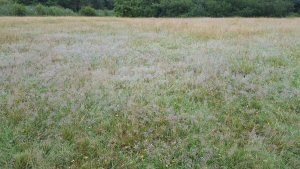 Grassy meadows had been created, parts of which are mown, but much is left to develop naturally, sprinkled with a succession of wildflowers. A cut is finally made in late summer. There are many narrow, well-trodden paths in the grounds, cutting through the meadows, made by the constant march of feet. It is an aesthetic pleasure to take such a path, especially when buttercups were dominating. These seemed early and not accompanied by meadow brown butterflies, which appeared later, the grass, of course, being the enticement. Grass can be beautiful, especially when covered in raindrops from a summer shower.
Grassy meadows had been created, parts of which are mown, but much is left to develop naturally, sprinkled with a succession of wildflowers. A cut is finally made in late summer. There are many narrow, well-trodden paths in the grounds, cutting through the meadows, made by the constant march of feet. It is an aesthetic pleasure to take such a path, especially when buttercups were dominating. These seemed early and not accompanied by meadow brown butterflies, which appeared later, the grass, of course, being the enticement. Grass can be beautiful, especially when covered in raindrops from a summer shower.
The grass was noticeably scarcer where yellow rattle dominated, as it is semi-parasitic on grass. Famous Victorian botanical illustrator Anne Pratt wrote, ‘…in the summer of 1839 it was unusually abundant in Essex. The country people of Essex had a remarkable prejudice against it, as they thought that its roots emitted some secretion of the plant, which burned the roots of the corn’.
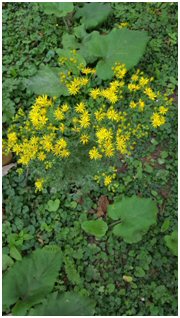
Some notable appearances:-
Large patches of yellow, frothy Lady’s bedstraw, perhaps deliberately planted to scent the edge of a small car park. In earlier days, this was useful when dried to stuff in straw mattresses, particularly for women about to give birth.
Lots of pleasing patches of purple common knapweed punctuating the grasses, (known also as bachelor’s button, blue bottle and iron knobs) This is a favourite of our pollinating insects, and was used in the past for ruptures and wounds, bruises, sores, scabs and sore throat (who needs pharmacies?).
Ragwort,( left) common or Oxford (I should have checked). Ingestion of a large amount in a short space of time can cause acute poisoning, particularly in horses and donkeys, resulting in death through liver trouble in a matter of days. Despite its bitter taste, equines will eat ragwort, especially when food is in short supply. I have seen working parties in the New Forest uprooting it. Although it becomes more palatable when preserved, it is still poisonous in a hay bale.
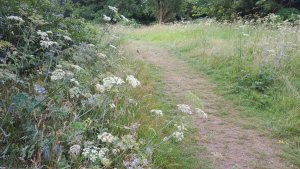 Common hogweed (not the dreaded ‘giant’), a native plant and a member of the carrot family, is found in one particular wooded area on what I call the ‘stinky path’ (right), beautiful to see but the smell was most unpleasant to me, but I’m sure delightful to visiting insects. One Michelin-starred restaurant makes a dish of hogweed with elderflower and sheep’s yoghurt. (Please do not try this!)
Common hogweed (not the dreaded ‘giant’), a native plant and a member of the carrot family, is found in one particular wooded area on what I call the ‘stinky path’ (right), beautiful to see but the smell was most unpleasant to me, but I’m sure delightful to visiting insects. One Michelin-starred restaurant makes a dish of hogweed with elderflower and sheep’s yoghurt. (Please do not try this!)
Hope you’ve had similarly pleasant walks during lockdown.
Sheila Crowson
A May walk in Maiden Erlegh Nature Reserve
On Monday 4 May, when out for a morning walk during the lockdown, I was really quite excited to glimpse a rare sighting of a little grebe swimming to and under the overhanging branches of Swan Island in Maiden Erlegh Lake. I had my camera with me and snatched a snap, regretting that I didn’t have a better lens. But I did get a picture, my first in several years of watching the local waterfowl.
This discreet and diminutive little bird – the clue’s in the name – appears to be an infrequent visitor to Maiden Erlegh, and even when it does arrive, it doesn’t draw attention to itself. Small, brown and favouring the bankside vegetation, the little grebe or dabchick spends much of its time submerged, diving for food. It is easily overlooked.
For years I had never seen one anywhere, though I began to come across them on ornamental lakes: at The Vyne and Stockbridge in Hampshire, and Blair Athol on holiday. So my interest was stirred when members of the Earley Environmental Group started to report occasional sightings. Grahame mentioned one in December 2013, John Booth almost exactly a year later, and Brian Hackett in January 2016. But I hadn’t seen one for myself, and was beginning to think I never would. Then in November 2017 I did see one, with the unmistakable angle of its neck and tail, and its characteristic dive.
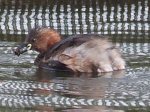 Most sightings, before and since, have been in the water above and below Swan Island, though they have been seen following the line of the bank on a couple of occasions and once, in the channel between the main island and the lake’s north bank. It seems clear, from the pattern of recorded sightings, that the little grebe is a winter visitor arriving for brief stops in late November or December and into the New Year, with the latest sighting, until this year, on 16 Feb 2016 (and being February, this was a conspicuous outlier). The sighting this May, however, was three months (a full season) later. What that betokens, we’ll have to wait and see.
Most sightings, before and since, have been in the water above and below Swan Island, though they have been seen following the line of the bank on a couple of occasions and once, in the channel between the main island and the lake’s north bank. It seems clear, from the pattern of recorded sightings, that the little grebe is a winter visitor arriving for brief stops in late November or December and into the New Year, with the latest sighting, until this year, on 16 Feb 2016 (and being February, this was a conspicuous outlier). The sighting this May, however, was three months (a full season) later. What that betokens, we’ll have to wait and see.
Edwin A.R. Trout
* * *
Inspiring young minds
Many of our famous naturalists have been inspired by someone to take an interest in nature when young. Read who inspired Lily Prior, aged 9, a member of the Junior Earley Environmental Group, run by Charlotte Allchin.
 Do you have a favourite naturalist? How did they inspire you and what were the most important lessons they taught you? As part of their March meeting before the shutdown, Earley Environmental Junior Group were asked to think about their favourite naturalists and describe why they found them so inspiring.
Do you have a favourite naturalist? How did they inspire you and what were the most important lessons they taught you? As part of their March meeting before the shutdown, Earley Environmental Junior Group were asked to think about their favourite naturalists and describe why they found them so inspiring.
We expected that David Attenborough would come up and that Steve Backshall might be chosen (as he was), and perhaps Chris Packham, Gerald Durrell or Jane Goodall. It was a particular treat, though, to hear about a naturalist from much closer to home, Roy Dobson, who is a member of the Berkshire Moth Group who has shared his fascination with moths, butterflies and insects in general with many people at different local events.
My inspiring naturalist by Lily Prior Aged 9
The naturalist that inspires me the most is my Grandad, these are the questions I asked when I interviewed him.
Why do you like bugs?
"Because most are very colourful."
What is your favourite bug?
"My favourite bug is a giant atlas moth.” (right)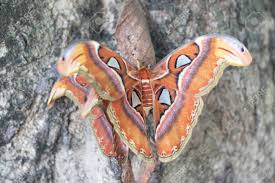
Have you loved bugs your whole life?
"Yes."
When did you get into bugs?
"I got into bugs at about 8 - 9. When I was at school I had to go to church 3 times on a Sunday! I was walking back from Sunday School one day, and I saw a whole load of Lime Hawk Moths. I took one back and put it in a pot. The next day it had done lots of poos so I threw them out on the grass. Later on, I found out from a book that they were actually eggs!"
When did you start breeding moths?
“About 1979. The first moths I bred were Indian moon moths."
Have you ever been published in a book?
"Yes! I was on the editorial team of a book called Common micro-moths of Berkshire.”
Wouldn’t all children like to have a grandad like Roy? Thank you, Lily.
* * *
As well as the Covid-19 pandemic, another seismic shift took place in global terms, the ‘Black Lives Matter’ movement erupted.
A shameful past in Earley
In the 18th century William Mathew Burt, Governor-General of the Leeward Islands, left a will dated 1776, showing that he owned Maiden Erlegh estate at that time. Like many estate owners, his wealth came from assets overseas, and was amassed through exploitation of people sold into slavery. In his will he refers to “my personal estate in the said island of St. Christopher’s (St. Kitts) being the negroes and stock upon my plantations being considered affixed to and part of the freehold”.
His wealth presumably enabled him to purchase Maiden Erlegh House and to pay Lancelot ‘Capability’ Brown to visit about 1778 for advice on improvements to his estate.
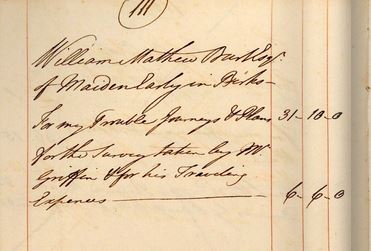 Brown is known to have ordered a survey and produced a plan for his client. Perhaps as a result of his advice, the ponds at the estate were later remodelled into a serpentine lake, and peripheral tree belts were added. Brown’s account book shows that he billed William Burt £31 and 10 shillings (almost £48,000 in 2015), and a further cost of £6 and 6 shillings (£9,600 in 2015) for the survey and travelling expenses of Cornelius Griffin. Brown may not have received payment as Burt died in 1781.
Brown is known to have ordered a survey and produced a plan for his client. Perhaps as a result of his advice, the ponds at the estate were later remodelled into a serpentine lake, and peripheral tree belts were added. Brown’s account book shows that he billed William Burt £31 and 10 shillings (almost £48,000 in 2015), and a further cost of £6 and 6 shillings (£9,600 in 2015) for the survey and travelling expenses of Cornelius Griffin. Brown may not have received payment as Burt died in 1781.
(Source: RHS Library Online ). Proceeds from the colonial past also enabled two local Nabobs to purchase Whiteknights and Maiden Erlegh (see newsletter June 2013).
* * *
Some thoughts that come to mind during Lockdown:
Clear skies, no planes…no roar of traffic…families walking together in local nature areas and cycling on near-deserted roads…birdsong loud and clear…observing wildlife in our gardens…an abundance of wild flowers.
Jean
My unstructured impressions of early lockdown were a greater reliance on and appreciation of the natural environment, focussed by daily exercise and limited options - an impression borne out by the greater number of people out and about on foot. So glad we had Maiden Erlegh and Redhatch Copse.
The ambience was characterised by peace and quiet, so the experience of birdsong was heightened, and of bright, clear and sunny weather, so that the colour of flowers was that much more vivid. Yellow celandine and archangel were particularly noticeable this year, as was pink honesty. The bluebells, when they came, were beautiful. In many ways, it was a perfect spring. Further afield, on my very occasional drives to the office, it was obvious that many more people were cycling, and on my weekly trips to deliver food to my parents, the Chiltern woodlands were much busier with ramblers than usual.
Edwin
Bringing you up-to-date with local affairs
Local Green Spaces
The Growth and Delivery Team of Wokingham Borough Council had asked for suggestions for areas to be designated as Local Green Space in the revision of the Local Plan. EEG responded with 14 locations, some of which form Green Corridors and Routes enabling flora and fauna to travel more easily across the area. The EEG committee has submitted its ideas, but more input is always welcome.
EEG's 2021 Community Calendar
Earley Environmental Group’s 2021 community calendar will be soon be available. Nearly 200 copies of last year’s calendar were sold, raising over £300 in support of the EEG’s activities. The calendar’s photos have been taken by local residents, and show scenes of the woods, lake, birds, flowers and fungi found in the Earley area.
More information on how to purchase the 2021 calendar will be made available soon, but if you would like to register your interest, please e-mail Bob Collis .
Bob Collis, Calendar Editor
eegphotocalendar@earleyenvironmentalgroup.co.uk
Death of an old-timer – the Luckmore/Betchworth Oak
The lovely old oak situated at the junction of Betchworth Avenue and Luckmore Drive is no more. It lost its fight against nature, being rotten at the base, and fell with a very loud noise during the night of April 13th. (See here for more details)
March 14th, Just over a week before Lockdown, and nature oblivious to the coming catastrophe!
On flagstones in our garden near the kitchen window a small group of birds was amicably picking up spilt birdseed . The group included a male and a female blackcap, a starling, female reed bunting and a partridge. It took seconds to pick up my camera, but just as I got back, one of our crow visitors swooped down and spooked them. So I can’t be sure if the partridge was grey or red-legged, but as grey is the commoner one and in the glimpse I had , nothing really bright caught my eye .......
We’ve been having small numbers of reed buntings visiting from 2006 till now, at various times between November and March.
Alice
STARLINGS NOTED BY GARDEN SURVEYORS: MAXIMUM SEEN ON ANY ONE DAY
| March: | Margaret 4 | Gillian 3 | Noisy and gregarious, starlings spend a lot of the year in flocks. When starlings flock together, wheeling and darting through the sky in tight, fluid formations, we call it a murmuration. Food: Invertebrates and fruit. Still one of the UK's commonest garden birds. Huge roosts can be found in plantations, reedbeds and city centres. UK breeding population: 1.8 million (source RSPB) |
| April: | Margaret 3 | Gillian 2 | |
| May: | Margaret 6 | Gillian 2 | |
| June: | Margaret 5 | Gillian 10 | |
LOCAL FORTHCOMING EVENTS August 2020 - December 2020
The programme of meetings and events is severely curtailed at the moment, just like other organisations. Watch the EEG website for updates, check on Facebook, or watch the council noticeboards.
|
Monday September 7th 7.30pm - 9.00pm Binfield Badgers by Zoom. |
Bits and pieces
In order to stay in touch during these difficult times, remember the Earley Environmental Group has a Facebook presence. Search for 'Earley Environmental Group' and we should pop up. We will be using this, in addition to the main website and the Newsletter, as a way of keeping everyone up-to-date with our activities, and to let you know about forthcoming events. At the moment, due to the Covid-19 pandemic, it is hard to project into the near future what these events will be, but we will also try to update you by e-mail, and post information on local notice boards. Members are also welcome to post news stories or any photographs relevant to the group. Look forward to seeing you on there.
EASI (Earley Adopt-a-Street Initiative) would like more volunteers. Help keep your street clear of litter. Everything provided. Phone Brian Hackett on 0118 986 1115 or email the organisers.
EEG committee members can be found on the EEG website, or phone 0118 962 0004
For Wildlife Survey Forms, go to the EEG website or phone Earley Town Council on 0118 986 8995
Comments or contributions to the newsletter to: the Editor or 2 Reeds Avenue, Earley, RG6 5SR. We would welcome short contributions from members to the newsletter.
If you know someone who would like to join EEG, membership forms are available from Earley Town Council, 0118 986 8995, or you can join on the website - just click on Join Here at the bottom of the home page. Please inform Liz if you intend to change e-mail or address at 50 Kenton Rd, Earley RG6 7LG, or send her an e-mail.
Erlegh Elfins: A pre-school playgroup on Thursdays at the Interpretation Centre in Maiden Erlegh Nature Reserve will run from 10 a.m. to 11:30 a.m., with a focus on outdoor play and exploration of the natural environment. For more information, please email Erlegh Elfins or phone Charlotte on 07771 605825.There is a limit on numbers to ensure safe play. Child-minders are welcome. Adults are responsible for the children they bring with them, so a ratio of 2:1 is recommended. A charge of £1.50 per child applies.
For information on Earley Environmental Junior Group, phone Charlotte as above.
Thanks to ORACLE Corporation for reproducing our newsletter on recycled paper. Oracle is the world's second largest software company, situated at Thames Valley Business Park in Earley. Oracle UK adheres to the ISO14001 Environment Standard which confirms Oracle has considered and acted upon its environmental impact. As part of Oracle’s corporate social responsibility they support a number of local groups, including us. They have given us valuable support in reproducing the hard copies of our newsletter in colour, as well as printing posters and membership leaflets for us to distribute to libraries, schools etc.